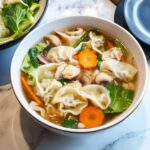Okonomiyaki is a popular Japanese savory pancake made with a batter of flour, eggs, shredded cabbage, and a variety of mix-ins such as seafood, pork, or cheese. The name “Okonomiyaki” translates to “grilled as you like it,” emphasizing its versatility. This dish is commonly enjoyed in Japanese street food markets and restaurants, often cooked on a teppan (iron griddle) and topped with a sweet-savory okonomiyaki sauce, Japanese mayonnaise, dried bonito flakes, and seaweed powder.
Full Recipe:
Ingredients
- All-purpose flour
- Eggs
- Shredded cabbage
- Water or dashi stock
- Protein options: pork belly, shrimp, or squid
- Green onions
- Okonomiyaki sauce
- Japanese mayonnaise
- Bonito flakes (katsuobushi)
- Seaweed powder (aonori)
Directions
- Prepare the batter by mixing flour, eggs, and water or dashi until smooth.
- Fold in shredded cabbage and any chosen proteins.
- Heat a griddle or non-stick pan and lightly oil it.
- Pour a portion of the batter onto the pan and shape it into a round pancake.
- Cook for a few minutes until golden brown, then flip and cook the other side.
- Transfer to a plate and drizzle with okonomiyaki sauce and Japanese mayo.
- Garnish with bonito flakes and seaweed powder.
- Serve hot and enjoy!
Nutrients
Per serving:
- Calories: ~350
- Protein: 12g
- Fat: 18g
- Carbohydrates: 35g
- Fiber: 4g
- Sodium: 600mg
The Unique Toppings and Sauces That Define Okonomiyaki
One of the most exciting aspects of Okonomiyaki is the variety of toppings and sauces that elevate the dish’s flavor profile. Traditional toppings include Okonomiyaki sauce, which is a thick, sweet-savory condiment similar to Worcestershire sauce but with a richer and slightly sweeter taste.
Japanese mayonnaise, another key topping, adds a creamy and slightly tangy contrast to the savory pancake. The combination of Okonomiyaki sauce and Japanese mayonnaise creates a balanced flavor that enhances the overall taste.
Bonito flakes, or “katsuobushi,” are thin, dried flakes of smoked tuna that add a deep umami flavor. When placed on top of hot Okonomiyaki, the flakes appear to “dance” due to the heat, making for an appealing presentation.
Aonori, or dried seaweed powder, is another common topping that brings a subtle oceanic flavor and vibrant color to the dish. For those who enjoy a bit of heat, shichimi togarashi (Japanese seven-spice blend) can also be sprinkled on top to add a spicy kick.
Why Okonomiyaki is a Popular Comfort Food
Okonomiyaki is often regarded as one of Japan’s ultimate comfort foods. Its combination of crispy edges, soft interior, and savory umami-packed toppings makes it a satisfying and hearty meal. It is commonly enjoyed at home, at casual restaurants, and even at specialized Okonomiyaki joints where diners can cook their own pancakes on built-in tabletop griddles.
One of the reasons Okonomiyaki is so comforting is its warm and hearty nature. The pancake is packed with ingredients that provide a balanced combination of carbohydrates, proteins, and vegetables, making it a filling and nutritious meal. The interactive aspect of cooking Okonomiyaki also makes it an enjoyable dish to share with family and friends, adding to its appeal.
The Versatility of Okonomiyaki
Okonomiyaki is an incredibly versatile dish that can be adapted to suit different dietary preferences and ingredient availability. While the classic versions feature cabbage, flour, eggs, and protein, there are countless variations to explore.
For seafood lovers, shrimp, squid, or scallops can be added to the batter to create a seafood Okonomiyaki. Those who prefer a vegetarian option can substitute meat with mushrooms, tofu, or cheese, which adds richness and texture. Some restaurants even offer modern twists, such as incorporating kimchi, mochi, or even bacon into the pancake.
For a healthier alternative, whole wheat flour or gluten-free flour can be used instead of all-purpose flour. Additionally, some variations reduce the flour content and increase the amount of shredded cabbage to make the pancake lighter and more vegetable-forward.
How to Enjoy Okonomiyaki at Home
Making Okonomiyaki at home is simple and requires only a few basic ingredients. While traditional recipes call for dashi (Japanese soup stock) to enhance the flavor of the batter, water can also be used as a substitute. The key to achieving the best texture is to mix the batter lightly to avoid overworking the flour, which can make the pancake dense.
Cooking Okonomiyaki at home also allows for customization based on individual preferences. Whether using a stovetop pan or an electric griddle, the cooking process is straightforward. The most important step is achieving a crispy exterior while keeping the inside soft and fluffy. Once cooked, adding generous amounts of sauce and toppings enhances the experience and brings out the authentic flavors of the dish.
Pairing Okonomiyaki with a side of miso soup, pickled vegetables, or a refreshing Japanese beer can complete the meal, making it feel like an authentic restaurant experience.
Okonomiyaki as a Social and Street Food Experience
Okonomiyaki is not just a delicious meal; it is also a significant part of Japan’s street food culture. In cities like Osaka and Hiroshima, food stalls and casual restaurants serve freshly made Okonomiyaki to hungry customers, often allowing them to customize their ingredients.
In Okonomiyaki specialty restaurants, diners may have the opportunity to cook their own pancakes on a built-in grill at the table. This interactive dining experience is fun and allows people to experiment with different ingredient combinations and cooking techniques.
Festivals and outdoor markets in Japan often feature Okonomiyaki vendors, where the savory aroma of sizzling pancakes fills the air. This accessibility and casual nature of Okonomiyaki make it a go-to choice for both locals and tourists looking to experience authentic Japanese flavors.
Conclusion
Okonomiyaki is a true representation of Japanese culinary creativity, bringing together simple ingredients to create a flavorful and satisfying dish. Its rich history, regional variations, and endless customization options make it a favorite among food lovers around the world. Okonomiyaki is a beloved Japanese dish that originated in the Kansai and Hiroshima regions. The name “Okonomiyaki” is derived from the words “okonomi,” meaning “what you like,” and “yaki,” meaning “grilled” or “cooked.” This name reflects the dish’s customizable nature, as it can be made with a variety of ingredients based on personal preference. Whether enjoyed as a home-cooked meal, a street food delicacy, or a specialty restaurant dish, Okonomiyaki offers something for everyone. The balance of textures, the umami-packed flavors, and the fun of making it from scratch contribute to its lasting appeal.






